| Back | Home | Index | On |
INSTRUMENTS & WARNING LAMPS
Each engine mariniser/manufacturer will supply both instruments and other warning devices with the engines. You are advised to check their wiring diagrams before altering the circuit because some use diodes to provide a feed for audible warnings under certain conditions.
This section only deals with the basic methods of wiring non-electronic instruments.
The engine itself will normally be supplied with:-
Coolant temperature gauge
Charge warning lamp
Low oil pressure warning lamp
Possibly a revcounter
Possibly an hour meter (may be built into the revcounter).
Any other gauges are usually extras.
All through the starting and charging system I kept on about checking your battery. The easiest way to do that on a daily basis is to fit an
Ammeter
Voltmeter
And if you do not want to run out of fuel and do not fancy storing a diesel soaked dipstick on the boat a:
Fuel gauge.
Fresh water and holding tank gauges just add more things to go wrong, but once you have worked through the circuits for the other gauges they should hold no mysteries for you.
AMMETER & VOLTMETER
A number of marine electrical suppliers offer fantastically clever "Amp Hour" gauges that are supposed to tell you how much charge is left in the battery bank(s) you have connected them to. These are fine if you have the money and you accept that once a battery starts to self-discharge due to a fault or old age, the gauge will not be exactly truthful. In my view you are better off with an ammeter, voltmeter, and a bit of common sense.
Voltmeters are available in different types – digital, moving coil and bimetallic. The later are really toys to give apparent added value to a control panel. They will be slow moving when first energised, have three coloured blocks on them and also refer to charging. I would advise leaving these instruments alone as a way of keeping your eye on the electrical systems.
I have no problems with either of the other two sorts apart from to caution that low temperatures can make a liquid crystal display, as found on a lot of digital voltmeters, inoperative.
For accuracy in reading any "needle" type voltmeter should have an "expanded scale" around the charging voltage part of the dial.
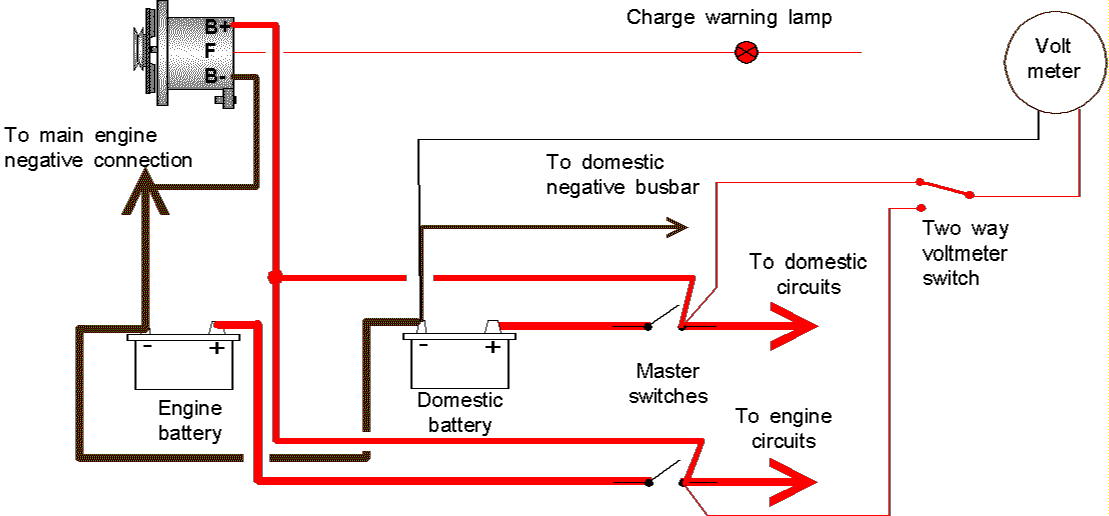
I always wire my voltmeter via a two-way switch, so I can use one meter to check both the domestic and engine batteries as shown below.
Charge splitting method is not shown
Mount the voltmeter and switch away from damp. The cable can be as thin as the BSS or Recreational Craft Directive allows because it carries virtually zero current.
If the BSS etc is not involved the meter could be wired from the other side of the master switches.
As this circuit is not normally fused take care to inspect regularly to ensure there is no chaffing or cutting of the insulation.
FAULT FINDING
As long as the meter gives approximately the same reading as a multimeter connected across its terminals there is no fault finding to do. However, the meter does allow you to do fault finding by noting and getting familiar with the "normal readings"
This indicates voltdrop on the lower reading circuit between alternator and battery.
There is probably a faulty cell developing in the lower battery, monitor water level in battery, relative density of cells (specific gravity) and any alterations in difference over a period.
The first two may be considered as one, but type 3 needs avoiding like the plague. It’s designed to provide a cheap and not particularly accurate "add on" for motor vehicles. They may have done well enough when the maximum output from a dynamo was about 25 amps, but now we are dealing with a minimum of 50 amps the wiring becomes expensive because the full current has to be taken from the charging system, up to the ammeter, and then back to the batteries. I have seen many examples of these instruments causing the alternator output to pulse up and down. I think this is related to the resistance caused by the long cable runs.
In my view the first two types only differ in potential accuracy and how the reading is displayed. Both types require a very, very low resistance to be inserted into the cable in which you are trying to measure current flow. This is known as a shunt and is of such a low resistance that it makes a minimal difference to voltdrop or circuit resistance. The ammeter and shunt are matched, so should be considered as one system.
Some digital meters are so sensitive that they can use the resistance of a length of the main charging cable as a shunt, but assume nothing – read the manufacturer’s instructions.
Specifying/buying the ammeter
In case 1a above you do not need a centre zero ammeter, but in 1b & c you need a centre zero meter so it can show current flowing into the battery or out of it.
A single ammeter, a double pole, two-way switch and TWO matched shunts would allow one meter to monitor two battery banks as appropriate
Once you know the maximum current flow specify the ammeter with the next highest maximum rating above. Going higher will allow for future alternator enhancements, but at the possible cost of a slight loss of accuracy (resolution).
The diagram below shows the position and wiring for the shunt required for the various options.
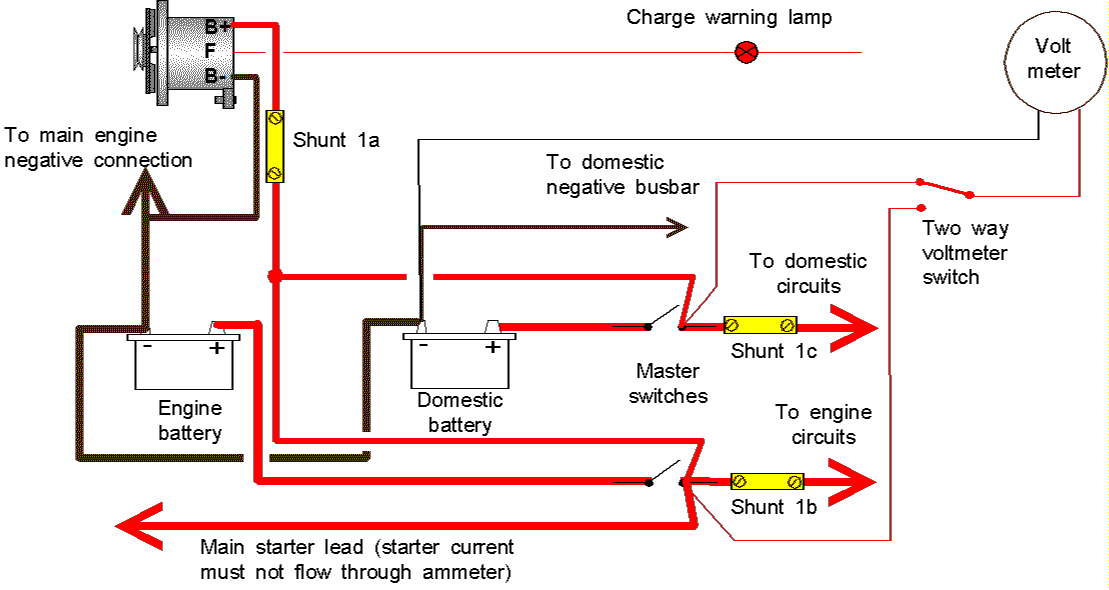
In my view, as you have already worked out your current flows (when you specified the cables etc.) there is little point in measuring the difference between the alternator output and current consumption.
You know what you have turned on, and for how long, so you can estimate the amp hours you have used.
You can read your charging current and estimate an average. You know how long you have been running your engine, so you can estimate the amp hours put back into the battery.
All you really need is to measure the alternator output. This:
Simplifies the wiring
Gives indication of alternator low output (failure)
Gives indications of loose drive belts
Allows you to estimate state of battery charge (with the voltmeter)
Allows you to assess the battery condition.
There is nothing wrong with 1b & 1c, but it is not so easy to estimate the state of the batteries or alternator condition because the engine/domestic loads will appear to indicate a lower alternator output.
Ammeters (more)
The important thing about shunted ammeters is that you must NEVER pass more current through the shunt than it is designed to take. This normally rules out trying to measure starting currant.
Ideally the shunt will be put in a NEGATIVE lead but this is not always possible. If you put it in the positive lead the small cables running to the meter can short circuit and burn.
Analogue meters will work in either the positive or negative lead. Digital meters may only work in one or the other and some may work in either lead. Some digital meters may require a totally separate power supply and that often involves a 9V battery.
The golden rule is to obtain a wiring diagram from your suppliers and use it!
Diagrams
The diagram in the book is just the start of an exercise. Shunt 1a measures the current flowing FROM the alternator while shunts 1b and 1c measure the current flowing to the circuits whether its is supplied by the batteries, alternator or a bit of both.
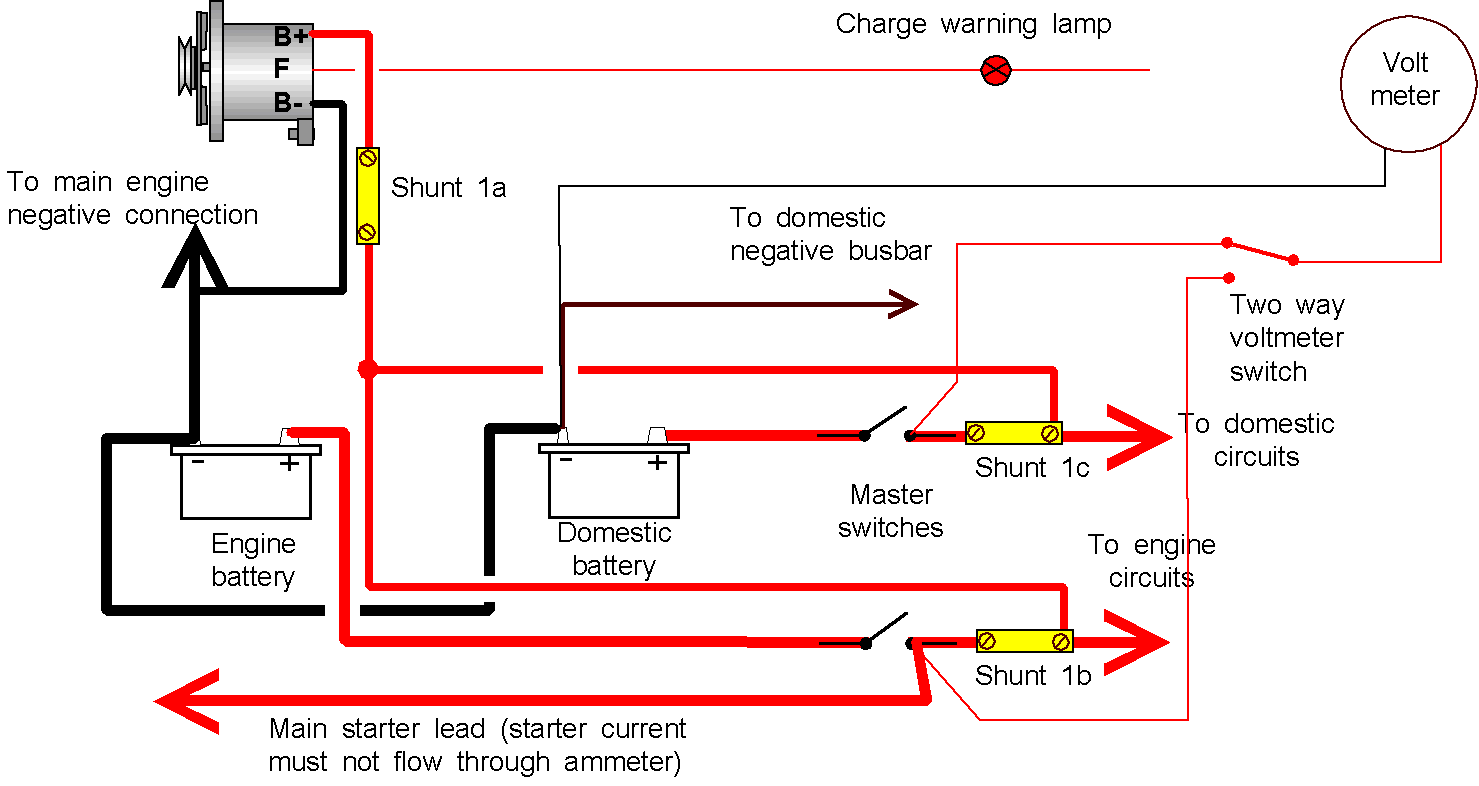
The above diagram now has shunts 1b & 1c measuring the current going into or out of the batteries but they are still in the positive, which is not a good thing.
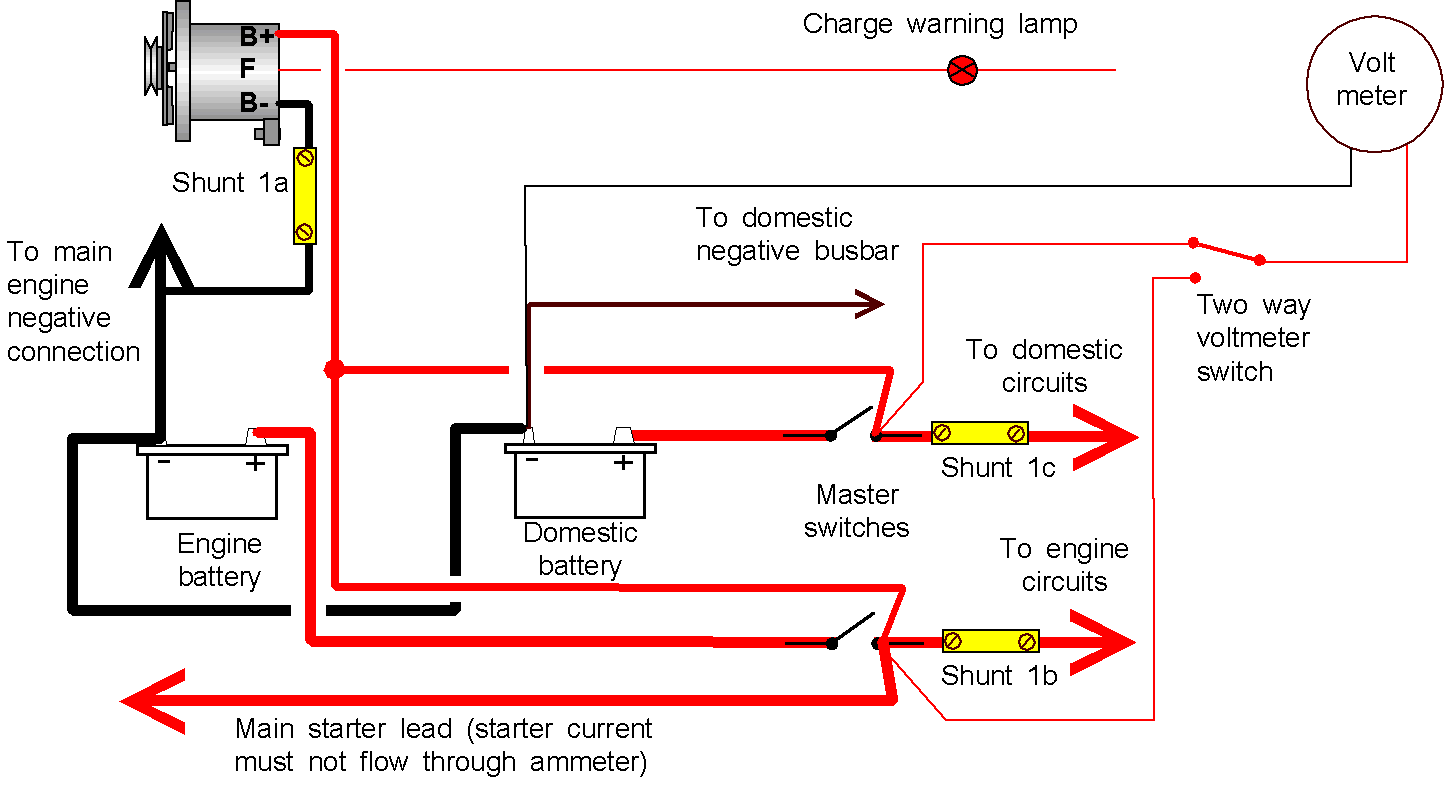
Now shunt 1a is in the negative lead measuring alternator output so it is safer but it will not measure any discharges. We can not put it in the main battery lead negative because it would then be subject to starter current.
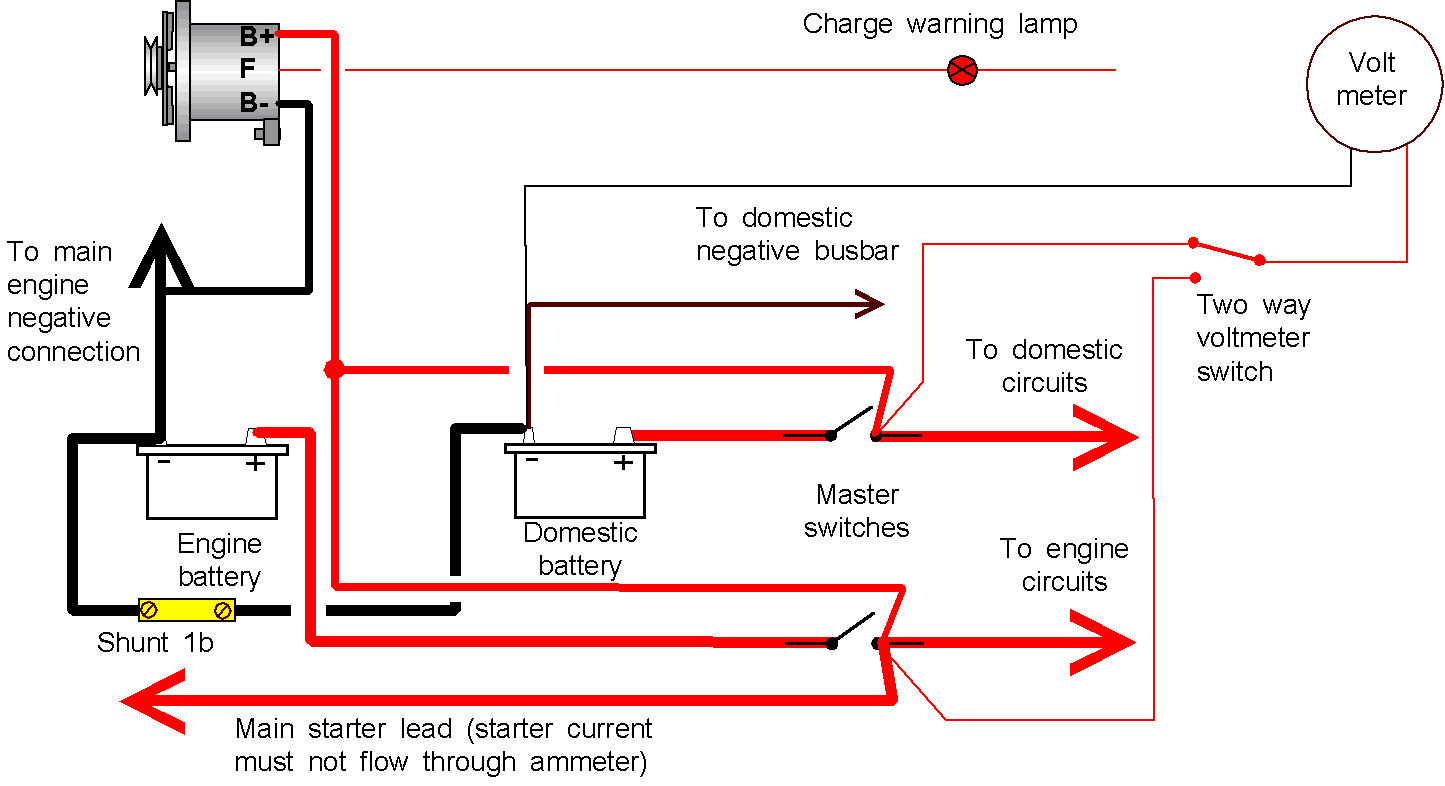
Shunt 1b is measuring the current into or out of the domestic battery and being in the negative lead is safer. Just take care with its current rating if you are using a large inverter!
Battery capacity meters
I fail to see how one of these meters can take account of the self-discharge of a battery nearing the end of its life. I would much rather be so used to checking my meters, that the longer charging time or the higher charging rate towards the end of charging would alert me to possible problems. The lower than normal battery voltage first thing in the morning (without adequate explanation) would also confirm my suspicions – but they do look impressive.
Inverters & ammeters
Inverters draw such heavy currents that care must be taken not to overload the alternator shunt when using inverter driven loads. This either means a very high current ammeter and shunt – expensive! or just measuring alternator output..
Wiring the shunt and meter
The main lead is cut and terminals fitted, taking care to ensure the terminals and their fittings are capable of handling the current.
The ammeter is then connected to either end of the shunt by thin wires. The cables carry virtually zero current, so they can be as long as you need and as thin as the recreational craft directive allows. This is shown below.
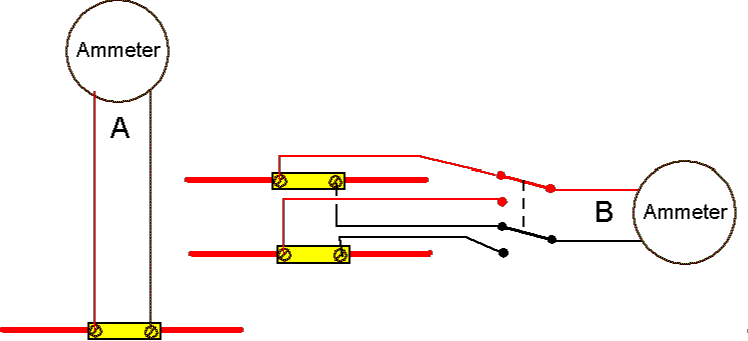
Diagram A shows the simple single shunt to single meter wiring whilst B shows two shunts feeding a single meter via a double pole, two way switch so either circuit can be monitored.
REVERSE READING AMMETERS
If, after fitting the ammeter and checking the wiring a centre zero meter reads in reverse, or a "left hand zero" meter refuses to read, simply reverse the thin cables on the shunt.
Ammeter fuses
It is not normal practice to fuse the shunt to ammeter cables, so take care to ensure they do not chaff or get cut. As with all wiring make a careful inspection on an annual basis. If one of the ammeter wires was allowed to short circuit it would catch fire, but being thin, one hopes that part of it would melt before too much damage was done.
FAULT FINDING
There is little faultfinding you can do on an ammeter you suspect is giving faulty readings apart from to inspect the wiring and shunt(s) for signs of damage. A good electrician should be able to work out what voltage to expect across the shunt or ammeter connections for any particular current flow, but this is beyond the scope of this book.
Soon after installing the meter set a multimeter to 2 volts and connect it across the shunt. Measure and record the voltage developed and the current registered a couple of minutes after starting with over 1500rpm on the engine. Repeat across the ammeter connections. Both readings should be the same, and once you have recorded them you can use this as a benchmark to check against in the event of future apparent faults.
Just like the voltmeter the ammeter can be used to infer faults in other systems.
One or more batteries beginning to fail – check relative density.
An item of equipment is going faulty and drawing more current.
Again a potential battery fault – check batteries.
Something has developed a permanent current draw.
Loose drive belt (may also screech on revving up, but a marine or heavy industrial based engine may not accelerate fast enough to do this).
Alternator starting to go faulty – suspect main output diodes.
High resistance on the main positive, negative, or sensing wire – check all cables and connections. Clean, tighten, remake as required. Do not forget the battery clamps.
Unless you are intent on using instruments from a scrap car, all the instruments work on the principle illustrated below – its just the scale and sender unit that differs to show temperature, oil pressure, fuel level etc. Novel forms of instrumentation are being introduced all the time, but few stand the test of time.
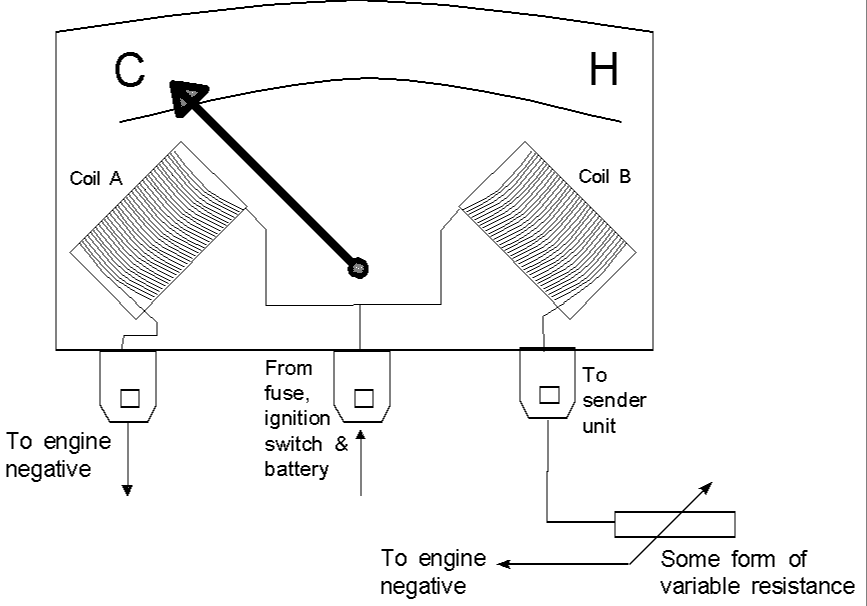
OPERATION
Current from the ignition switch flows to the centre connection (on this diagram) and can then flow in two directions – through coil A and also through coil B.
The amount of current flowing through each coil will be governed by the resistance of the circuit that each coil is part of.
The higher the current flow, the stronger the electromagnet that will be formed by the coil.
The only resistance in the coil A circuit is the resistance of the coil itself, so a known current flows, producing a known strength of magnet.
The Coil B circuit also has the resistance of the sender unit in it.
With a low resistance in the sender the current flow through coil will be high, the magnetism produced will be strong, so the needle will be attracted away from coil A towards the H position.
With a high resistance at the sender the current flow through coil B will be small, so the magnetism will be weak. This allows coil A to pull the needle back to the C position.
The needle will always be balanced between the two magnetic fields and its position will depend upon the resistance of the sender.
If the negative connection for coil A goes resistive or breaks the current flow through coil A will either fall or stop, so the instrument reads higher than it should – this is often overlooked.
Types of gauge
Not all instruments use two coils placed as shown, some wind the two coils, at right angles to each other, on the needle spindle, and surround them with a permanent magnet. Whichever sort you have need not concern you, because the basic operating principle and fault finding holds good for both types.
"Marine" instruments
The gauge shown is a proper marine gauge because the negative connection for coil A runs to a separate and insulated terminal. In real life the instrument may well be an automotive one with the coil A negative connection made to the case, or a marinised one with the negative connection simply riveted to the case.
Similarly an illuminating lamp may well only have one terminal, with the negative side connected to the case.
On wood or GRP boats a negative cable fitted to one of the instrument mounting screws will suffice if there is no negative connection.
On any metal boat you should only have one "earth" point, and this will usually be at the starter motor negative connection, to avoid the possibility of stray negative currents causing corrosion to the boat’s structure. Although this is likely to be very small it is simply not worth the risk, so:-
On metal boats always use a non-conductive material for your instrument mounting plate. This can be wood or some form of plastic. This way you will not have to worry about exactly how the instruments and their illuminating lights are connected to negative.
Temperature gauges use a heat sensitive resistor called a thermistor mounted inside a brass bulb in the sender unit.
Oil pressure senders use one of several sender types. All are fairly complicated, some using heated bimetallic strips and contacts, but all may be considered as altering their resistance as the oil pressure varies (even although some keep turning coil B on and off quickly).
Fuel and oil level gauges normally use a float moving a mechanical wiper over a variable resistor.
There are always novel forms of fuel, water and black water senders and gauges being marketed. For these you will need the manufacturer’s instructions.
In all cases the sender unit will require a negative connection. This will normally be made to the case on engine mounted units, but ones mounted on tanks will also require their own negative connection and cable. This may have a dedicated terminal or it may require a terminal being fitted under a mounting screw.
Some engine-mounted senders have two terminals – TAKE CARE - do not assume these are the instrument connection and the negative. It is more likely to be the instrument connections plus an audio-visual danger warning connection. A temperature sender of this type is shown below.
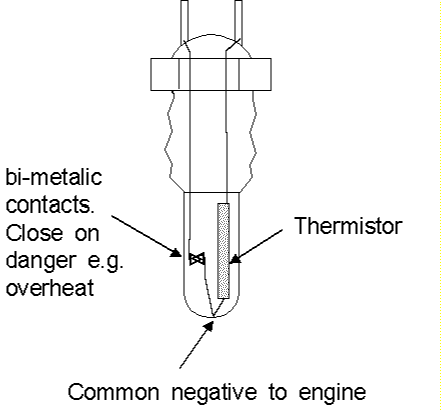
The thermistor provides the varying resistance according to temperature.
The bimetallic contacts close when the temperature becomes too high, either illuminating and overheat warning lamp, sounding an alarm, or both.
To see if it is a sender of this type set the multimeter to about 20k ohms resistance and test between the case and each terminal. If both show infinity (an I on the "wrong" side of the scale) the unit is thermistor only. If only 1 terminal gives infinity it is this type. The infinity reading terminal connects to the alarm circuit.
Instruments and most warning lamp circuits are often fused. One fuse is normally sufficient for all instruments and fused warning lamps. However as the instrument or warning lamp itself will limit the current flow in case of most faults, and as the wiring from the ignition switch to the instruments is usually short (minimising the likelihood of a short circuit to negative) one need not get too worried if a particular boat is not fused. A 10 amp fuse for all instruments, warning lamps and instrument illumination should be more than sufficient. In many cases a single "inline" fuse holder will suffice.
Instrument circuits
A typical circuit for three instruments is shown below. The instruments could
well be Engine temperature, fuel gauge, and oil pressure, or any other. Just remember that
both the instrument and the sender unit requires a connection to the main engine negative. First you must decide when you want them on and what will switch them on –
or even if you want them at all. Most inland craft can probably do quite well without
them. On inland craft I would suggest that they be fed (If wanted) from the tunnel
light switch or from the navigation light switch if fitted. Other craft may want to feed them either from the navigation light switch or
from the domestic batteries via their own switch. The latter would ensure that they do not
put any drain on the engine battery. Ideally you would fuse in this circuit, although the fuse for whatever circuit
you are feeding it from should suffice as long as you allow for the instrument lights in
your calculations. The circuit 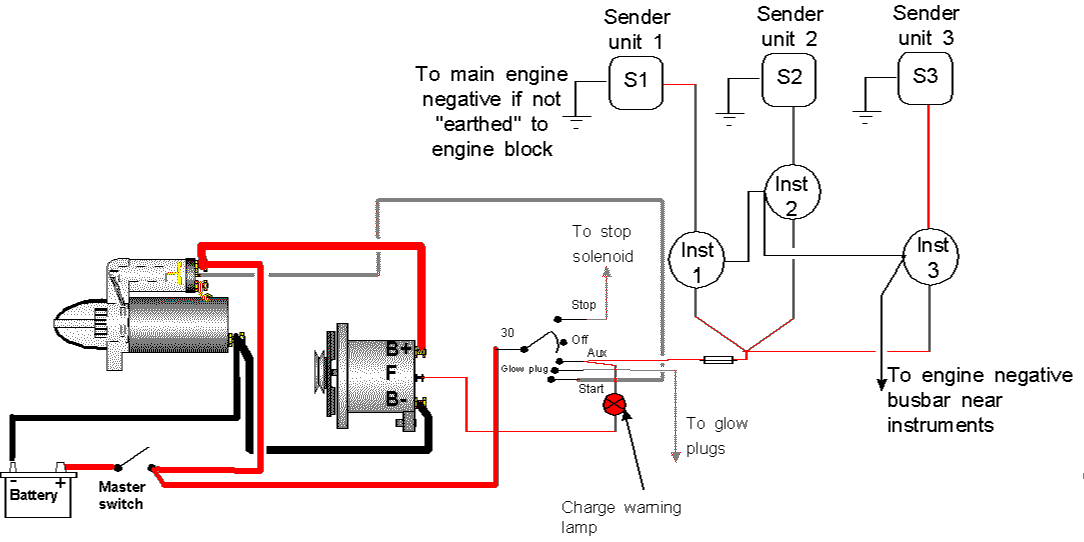
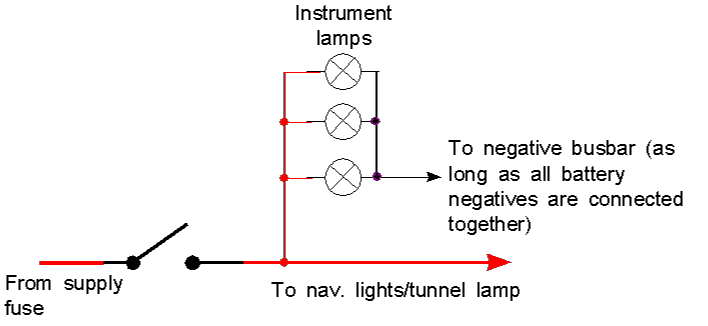
These include the oil pressure and overheat warning lamps, overheat and low oil pressure buzzers, exhaust temperature monitors (on wet exhaust boats) etc. For the purposes of the wiring we may consider the bulb and the buzzer as identical units. Both will only take a very small current and both will have senders remote from the warning device.
Some sender units will have two terminals on them, other will be wired internally to go to negative through the engine block. In the later case you must wire them in a similar manner to the gauges, but if there are two terminals you could (if you decided there was some merit in it) supply a live to the sender and then run a wire back to the warning device. This is not very sensible as stated below.
Fusing warning lamps and buzzers
Just like the gauges, if you send the current to negative via the sender you will protect most of the circuit from fault damage by the resistance of the bulb or buzzer. You will also save on lengths of cable.
I would always wire them this way.
Traditionally it has not been practice to fuse vital warning devices like oil pressure warning lamps. The thinking being that a bit of smoke from burning wiring is less costly than a new engine. I am not sure I agree with this.
If you feed these circuits via the instrument fuse you will know when a fuse blows because all the instruments will stop working – that will force you to investigate.
The circuit
The circuit below assumes that you will feed the warning devices from the instrument fuse. Only three units are shown as examples.
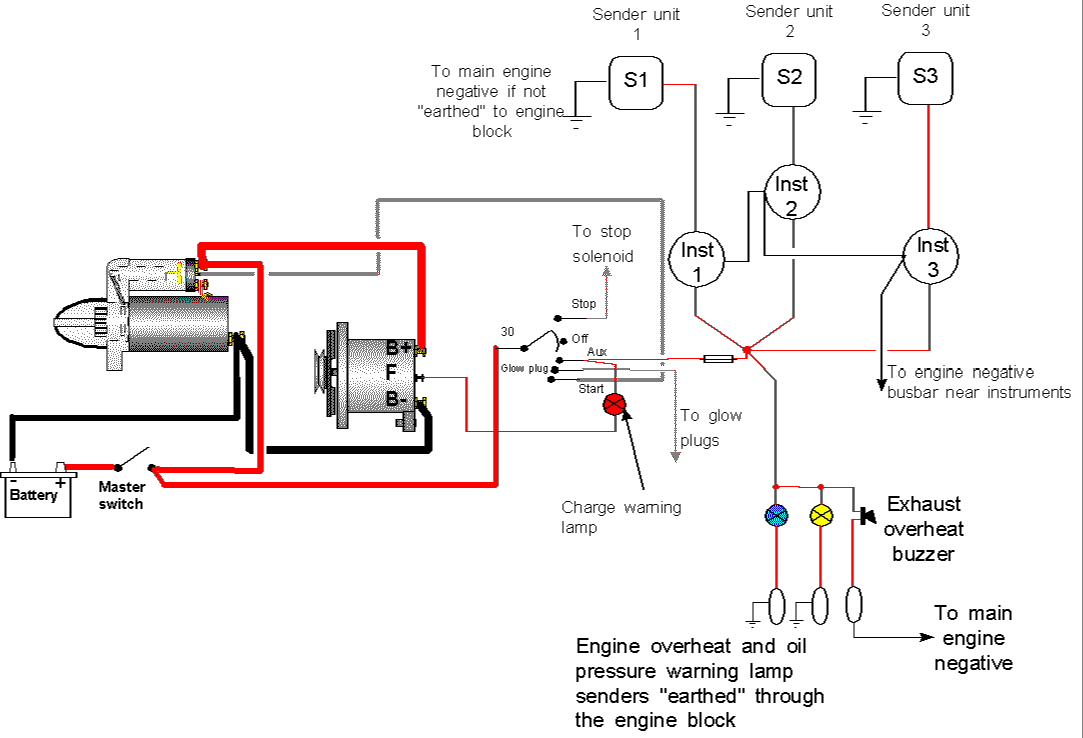
It all starts to look complicated, but take one instrument or warning lamp at a time and wire it to its sender. Then work out if you need to connect the sender to the main engine negative connection.
Loosely bundle the wires with pieces of insulating tape or zip ties so you can feed more cable through, and then move onto the next instrument.
Instrument and Warning Circuit Fault Finding.
This section assumes that all sender units have been wired so they are fed via the gauge or warning lamp.
Disconnect lead from sender.
Gauge drops to minimum or lamp goes out = faulty sender unit.
Gauge stays where it is = fault on wiring (short circuit to negative on feed wire to sender), resistive negative connection to gauge.
Make a temporary connection between gauge negative and battery negative, if gauge drops it is a bad negative connection, if not it is likely to be a faulty gauge..
Lamp stays on = fault on wiring (short circuit to negative on feed wire to sender)
Disconnect lead from sender and join it to battery negative (or engine block if that is connected to battery negative).
Gauge rises to maximum or warning lamp comes on = faulty sender.
Gauge stays where it is or lamp stays off.
No feed, broken wire or bad connection between sender and gauge or warning lamp.
Use voltmeter to ensure 12 volts to gauge or bulb – if not blown fuse or broken wire/connection.
Make temporary connection between gauge or bulb terminal to sender and join to a negative
Gauge rises or bulb on = broken wire or bad connection between gauge or light and sender.
Gauge stays the same = faulty gauge
Bulb stays off = blow bulb (most likely)
WARNING – Some engines use diodes in their warning circuits. Before spending any money consult the engine’s wiring diagram. If necessary consult a professional about testing any of these circuits with diodes in.
These normally require a live feed that is only turned on when the engine is running. This can be provided from:-
The auxiliary terminal
The warning lamp terminal, but this may require a slightly higher rated warning lamp or higher engine revs to start the alternator charging.
Never try to use a phase tap for this or anything else other than a suitable revcounter!!!
Ideally the counter should have a fused feed, but the wiring is normally so short that the chance of a short circuit developing is very small. If you are feeding it from the ignition switch use the instrument fuse.
The other terminal on the counter should be connected to the engine negative busbar.
If it has an illuminating light wire as in the section above.
Do not mount ON ENGINE – the vibration can have an effect on the life of the unit!!
Fault finding the hour
counter Use a voltmeter to check that you have 12 volts across the unit when the engine
is running. You have 12 volts = faulty counter. You do not find 12 volts = fault in wiring or supply. Blown fuse Disconnected terminal somewhere Broken wire in positive or negative cables.
Revcounters come in four main types. The difference is how they "measure" the engine revs.
Mechanical types These are effectively car speedometers, driven by a cable, with a different
dial fitted. The only electrical thing may be an illuminating bulb – see above. To faultfind simply check the inner cable. The engine drives a small generator or alternator. This is connected to the
revcounter by two cables. Often this is all the connections required (apart from
illuminating bulbs), but some may also require a separate positive and negative cable. If so, supply the positive from the instrument fuse. To faultfind first measure the voltage across the sender at fast idle and note
it in your little black book – you may need to use the AC voltage scale. Note if you
got the reading on the AC or DC scales. When the unit fails to work, check the reading you get then against the black
book readings. If they are similar repeat at the gauge. Similar readings indicate a faulty gauge. Lower readings indicate a wiring fault or a faulty sender unit. The sender unit consists of a permanent magnet joined to a coil wrapped around
a piece of soft iron. The tip of the unit is placed close to some form of steel teeth
fitted to a rotating part of the engine. These are often flywheel gear teeth or timing
gear teeth, but can just as easily be a toothed ring bolted behind the crankshaft pulley. When the tip is close to the tooth, the tooth and engine form an easy
"magnetic circuit" so there is a strong magnetic field around the coil. As the tooth moves away from the tip the magnetism has to pass through a larger
air gap, so the magnetism "spreads out" weakening the field around the coil. This pulsing field produces an interesting AC waveform in the coil. This
pulsing voltage is passed to the gauge unit where it is counted and displayed as rpm. The revcounter unit will require connecting to the two cables coming from the
sender. These may be inside a metal braid screen that requires connecting to the engine
negative/block. A live feed and negative is also required – use the instrument fuse
and engine negative busbar. To faultfind use an oscilloscope or frequency meter plus AC voltmeter to
measure the frequency and voltage from the sender at fast idle – note in little black
book for future comparison when the counter stops working. Check the counter unit still has a supply and negative. The airgap between the "tooth" and sender tip can be critical. Try to
get the manufacturer’s measurement and check it is still the same on a regular basis. If you have no measurement, try to get the tip as close to the tooth as
possible without any danger of physical contact – but only after the system has
stopped working! These are the latest types fitted to diesel engines. They get a pulsing signal
from a phase tap on the alternator. If the alternator does not have a dedicated revcounter
terminal, and most do not, you will need to get one soldered to one of the phases. The counter unit also needs a positive and negative supply (use the instrument
fuse). You will need some information: Engine crankshaft pulley circumference or diameter Alternator pulley circumference or diameter (Both the above are needed to work out the pulley ratio). How many poles the alternator has on its rotor. Rather than strip the alternator, it would be easier to take a note of its part
number and manufacturer, and ask your local autoelectrical specialist or the technical
department of the manufacture how many poles it has. The number of poles is probably six north and six south. I suspect this is
normally referred to as a six pole machine. On the back of the revcounter will be some method of setting it up to take
account of the above data. This could be a line of very small switches or a screw to
twist. For absolute accuracy check the unit against a mechanical revcounter and make
sure the fan belt never slips – in fact it probably will slip to give a reading about
2% low, but you will not be able to see this because of the scale. Faultfinding involves checking the pulses present (frequency) at the alternator
phase tap and at the unit, and then checking for a feed and negative connection. Take a
fast tickover reading a.s.a.p. and put it in the book for later comparison.
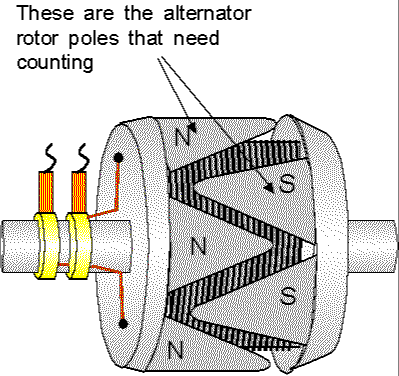
Coil sensed These are only found on petrol engines. They need a positive and negative
supply and also a sensing lead from the coil Bat terminal (normally + on a boat, but
someone may have wired it positive earth, in which case it will be -) The back of the instrument should have a set of switches to select the number
of cylinders.